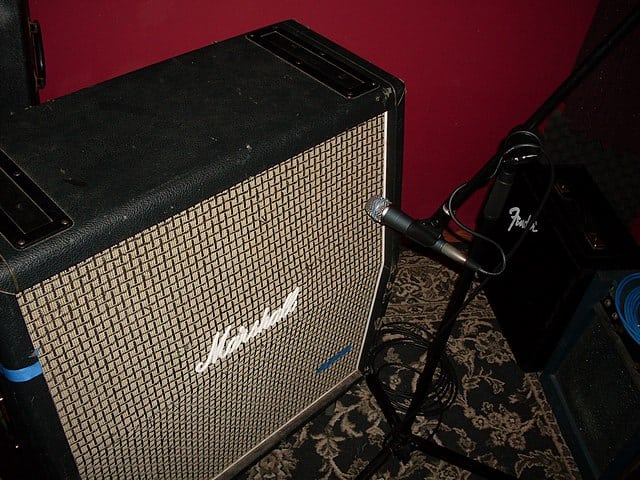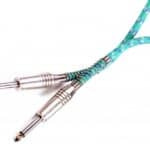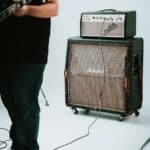Knowing which cables to use for your equipment is an important part of being a musician.
Using the wrong one can even damage your system, but it’s easy to understand once you know what to look for.
Speaker cabinets use speaker cables, which are usually unshielded mono cables designed for use between speakers and as a source of amplification. They usually come in 12-Gauge 1/4”-1/4” measurements. Unlike instrument cables, speaker cables are unshielded with lower impedance to allow easier electrical output.
If this still doesn’t make much sense to you, don’t worry, you’ll find everything covered in more detail down below.
Overall, it’s not rocket science and once you know the key differences, you should feel less intimidated by sound equipment setup.
Can you connect a speaker cabinet to an amp with an instrument cable?
You cannot, unfortunately. Instrument cables aren’t made to carry the load required for the signals to travel between an amp and speaker system.
Generally, the resistance formed by the shielding is too high and won’t be good for your system or cables.
Do you need special cables for speaker cabinets?
You want to get proper speaker cables with unbalanced ¼” connectors because you need an unhindered electrical signal able to travel the cable.
The low impedance of speaker cables means that they run at higher voltage, meaning they would be negatively affected by high resistance, hence the need for at least 12” wires.
The key difference between the instrument and speaker cables is that instrument cables are shielded with much smaller wire gauges while speaker cables are generally thicker.
Instrument cables need to be shielded because of the high impedance environment in which they connect to amplifiers.
If you’re wondering about speaker cables picking up noise, they generally don’t despite not being shielded.
The only time you will get noise is when the signal strength of a cable is relatively lower. Like in the case of your guitar cable to your amp.
What can happen if you don’t use the right cable?
If you use an instrument cable as a speaker cable, you’re probably OK at low signal levels, but at a higher signal, you’ll be met with trouble.
The main confusion tends to come from the fact that both speaker cables and instrument cables tend to share the same connectors – ¼” plugs. That’s the only real similarity that they share, though.
Mixing up the wrong cables for the job can lead to problems from small things like interference to major ones like equipment failure.
The best way to think of it is to visualize the current as water flow.
From your guitar to your amp, you don’t need a lot of current because the signal from your guitar’s pickup doesn’t need that much juice to carry to the amp.
The shielding on your instrument cables helps to prevent the interference that this lower current usually faces, but it also means that instrument cables have higher impedance, which works best at their lower currents.
The amp amplifies that signal from your guitar and then needs to be able to send it to your speaker, now at a higher current.
So with that greater current, you needed bigger piping to carry that flow without resistance, hence why speaker cables aren’t shielded and are thicker.
Can you damage the amp or the speakers if you use a guitar cable?
Yes. Especially at cranked volumes. If you use the wrong cables, in this case, an instrument cable in place of a speaker cable, you’ll experience a lot of amp power converting to heat.
This means that the signal to your speakers will come out weaker for one, and secondly, your amp and cables can overheat. You will likely get distortion along with this and if you leave it too long it could lead to connection failure.
You also don’t want to overheat your amp.
Why do you need a special cable to connect amp heads to cabinets?
The greater signals that travel from the amp to the speaker mean that they will flow at a higher voltage. Speaker cables are equipped for this high voltage by having a thicker gauge and by not being shielded, their lack of shielding has two reasons:
- At high signal levels, interference isn’t a concern
- Speaker cables need lower resistance for the higher signal output to carry without issue
There are a lot of other specialized cables for other connections to different systems and while the sheer number of variances can be overwhelming to a beginner, they’re all logically set out.
I won’t cover all the other cable types in this post, because speaker and instrument cables will be your main concern as a guitar player for the most part.
If you’re ever in doubt about which gear to use when purchasing, ask the merchant you’re buying from, they’ll be happy to point you in the right direction and probably even take the time to explain the differences and how to spot them.

Hello there, my name is Ramiro and I’ve been playing guitar for almost 20 years. I’m obsessed with everything gear-related and I thought it might be worth sharing it. From guitars, pedals, amps, and synths to studio gear and production tips, I hope you find what I post here useful, and I’ll try my best to keep it entertaining also.





